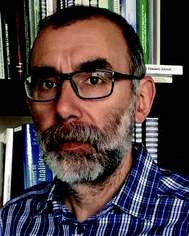Analysis of nanomaterials by field-flow fractionation and single particle ICP-MS
Björn
Meermann
a and
Francisco
Laborda
b
aFederal Institute of Hydrology, Department G2 – Aquatic Chemistry, Am Mainzer Tor 1, D-56068 Koblenz, Germany. E-mail: meermann@bafg.de
bUniversity of Zaragoza, Institute of Environmental Sciences (IUCA), Group of Analytical Spectroscopy and Sensors (GEAS), Pedro Cerbuna 12, 50009 Zaragoza, Spain. E-mail: flaborda@unizar.es
Around the turn of the millennium engineered nanomaterials (ENMs) and in particular engineered nanoparticles (ENPs) started to become prominent due to an expanding nanomaterial industry. This has led to an increasing number of materials in the nanometer range being designed and incorporated into daily-life products (clothing, cosmetics…). Additionally, applications of ENMs in food and medicine are also gaining in importance. The analytical sciences have been involved in the field from the beginning. At first, just characterizing pristine nanomaterials, but more recently, detecting, quantifying and characterizing these nanomaterials in complex and real-world samples. In fact, obtaining information about nanomaterials in the same way as other conventional analytes is one of the big challenges for the analytical sciences at present.
By way of example, the definition for nanomaterials launched by the European Commission considers:
“[…] ‘Nanomaterial’ means a natural, incidental or manufactured material containing particles, in an unbound state or as an aggregate or as an agglomerate and where, for 50% or more of the particles in the number size distribution, one or more external dimensions is in the size range 1 nm–100 nm. In specific cases and where warranted by concerns for the environment, health, safety or competitiveness the number size distribution threshold of 50% may be replaced by a threshold between 1% and 50%”.1
However, making a decision according to this definition of whether or not a sample can be considered a nanomaterial is not trivial. The problem can be even more complicated if the decision involves not just knowing if a sample is a nanomaterial but if it contains a nanomaterial, especially in the presence of complex matrices and at low concentrations. To cope with these challenges, the development of innovative and reliable analytical methods and techniques is the main priority of analytical scientists working in this area. Field-flow fractionation (FFF) and single particle ICP-MS (SP-ICP-MS) are certainly two prime examples in this regard.
In the 1990's a promising hyphenated technique based on FFF coupled to ICP-MS was introduced,2 and was at first applied to environmental samples for studying the interaction of trace metals and different natural colloids. One of the most important functions of natural colloids is their capacity to bind and transport large amounts of, for example, trace and toxic metal(loid)s, and radionuclides, functioning as a carrier for these substances and influencing their bioavailability. FFF-ICP-MS turned out to be an excellent tool to fractionate and sensitively detect metal/metalloid-containing colloids up to micrometer-size. Hence, as a sort of natural evolution, FFF-ICP-MS was successfully applied to ENMs/ENPs analysis, and since about 2010 applications have increased continuously. A second emerging technique is SP-ICP-MS. The feasibility of SP-ICP-MS for the analysis of colloidal and ENPs suspensions was demonstrated in 20063 and it has evolved even faster than FFF-ICP-MS since 2011.
Furthermore, a trend that has increased in importance during recent years is the complementary use of FFF-ICP-MS and SP-ICP-MS in ENPs analysis: FFF-ICP-MS offers the ability to fractionate nanomaterials down to the nanometer range, while SP-ICP-MS provides a distinction between dissolved and particulate fractions at concentrations down to parts-per-trillion levels. Additionally, whereas the mass-based information obtained via FFF-ICP-MS can only be transferred to number-based data upon some estimations, the complementary use of SP-ICP-MS provides direct number-based results. Multi-elemental detection within SP-ICP-MS was hindered due to too slow scan speed and hence is enabled by combination with FFF-ICP-MS. However, recent instrumental developments based on the use of fast scanning quadrupoles and time-of-flight mass spectrometers are enabling multi-elemental detection within single particles.
The topical emphasis of this themed issue collection reflects the trend that FFF- and SP-ICP-MS are nowadays more often applied in ENMs analysis rather than natural colloids: one paper highlights the applicability of FFF-ICP-MS on groundwater colloids whereas six papers highlight strategies for the analysis of some relevant ENPs (Au, Ag, TiO2, SiO2, Se) in a variety of complex samples (food, waste water, culture medium, biological tissues).
However, this shift in application trend does not downgrade the current use for colloid analysis. Hence, Saito et al.4 have applied FFF-ICP-MS in conjunction with UV/Vis and fluorescence detection for the analysis of granitic and sedimentary deep groundwater colloids, and have discovered two different organic fractions potentially acting as radionuclide carriers.
As mentioned, SP-ICP-MS has turned out to be a promising tool for ENPs analysis. Furthermore, many laboratories possess an ICP-MS instrument. However, data treatment in SP-ICP-MS is not straightforward, and in most cases each lab which conducts SP-ICP-MS has established its own strategies for data treatment. Peters et al.5 have investigated SP-ICP-MS as a screening tool for the analysis of ENPs in complex matrices in light of routine applicability. Moreover, they have developed a software tool for data assessment and investigated the implementation of SP-ICP-MS for routine analysis.
Next to data assessment, fundamental ICP-MS aspects (plasma conditions, particle vaporization…) with regard to linear size-calibration ranges of ENPs have to be taken into account especially for high particle masses. However, linear calibration curves are a prerequisite for SP-ICP-MS to end up with valid results. Lee et al.6 have compared different size-calibration strategies and optimized plasma conditions with regard to the type of ENPs analyzed.
SiO2 is one ENM dominating the market of nanomaterials with regard to production volumes and applications in consumer products. Determination of SiO2 nanoparticles (SiO2ENPs) by SP-ICP-MS is constrained by the attainable size detection limits (approx. 200 nm) due to sensitivity and background issues. This is not the case for FFF-ICP-MS, and Aureli et al.7 have developed a FFF-MALS-ICP-MS/MS multi-detector approach for the characterization of SiO2NPs.
Sample preparation is the “Achilles' heel” in ENMs analysis, given the fact that slight changes of the matrix can influence the stability of nanoparticles in suspension leading to their agglomeration/aggregation. Hence, general protocols/strategies are needed for sample preparation. Wagner et al.8 have developed a generic sample preparation protocol and applied it for SiO2ENPs analysis by FFF-MALS-ICP-MS in tomato soup, as a proof of concept application.
Other nanomaterials in several daily-life products are Ag nanoparticles (AgENPs). AgENPs are incorporated in clothing, paints and cosmetics as antimicrobials. Furthermore, AgENPs are more prone to dissolution and less stable than other nanoparticles, like SiO2ENPs. Hence, optimized analytical strategies are also needed for the analysis of AgENPs in real-world samples, especially with regard to the EC definition. Cascio et al.9 have used an FFF-ICP-MS method, developed initially for the analysis of AgENPs standards, for the analysis of AgENPs contained in antimicrobial consumer products. The authors' objective was to check the applicability of a single method to a range of real-world samples to end up with a generic method for this type of sample, involving mathematical conversion from mass-based to number-based results.
A further promising field of application of ENMs is within the medical sector. ENPs are envisaged and tested as drug or nutrient carrier vehicles. Palomo-Siguero et al.10 have studied the uptake and biotransformation of Se nanoparticles (SeENPs) in radishes by means of FFF and complementary HPLC-ICP-MS methods to allow for the evaluation of SeENPs as a way of delivering selenium in food.
ENMs can offer new and beneficial properties. However, validated analytical methods are urgently needed to fulfil regulatory demands on the one hand, and to study their fate and biotransformation in complex biological and environmental systems on the other. As highlighted within this themed issue collection, FFF-ICP-MS and SP-ICP-MS are promising, powerful analytical techniques to separate and quantify (either mass- or number-based) ENPs in the low nanometer range. However, up to now method development is mostly directed to specific samples and analytes. With regard to regulatory aspects, generic method development protocols are required. Furthermore, the papers compiled within this themed issue highlight the applicability of these ICP-MS based techniques to real-world samples and the good comparability to well established techniques like TEM, DLS, or MALS. Additionally, it turned out that mostly a couple of complementary techniques are required in terms of ENMs analysis; not least owing to the fact that stable, certified reference materials are still lacking.
In closing, we would like to thank all authors for submitting high quality manuscripts enabling us to compile this themed issue, and the colleagues who took their time to review the submissions. Furthermore, we would like to give special thanks to May Copsey and the Editorial Board of JAAS. In particular we would like to acknowledge Matt Cude and Harriet Brewerton for their hard work, organization, and support enabling the publication of this themed issue. We appreciated the collaboration a lot.
References
- European Commission (2011) Commission recommendation of 18 October 2011 on the definition of nanomaterial (2011/696/EU), Official Journal.
- R. Beckett, At. Spectrosc., 1991, 12, 228–232 CAS.
- C. Degueldre and P. Y. Favarger, Colloids Surf., A, 2003, 217, 137–142 CrossRef CAS.
- T. Saito, T. Hamamoto, T. Mizuno, T. Iwatsuki and S. Tanaka, J. Anal. At. Spectrom., 2015 10.1039/c5ja00088b.
- R. Peters, Z. Herrera-Rivera, A. Undas, M. van der Lee, H. Marvin, H. Bouwmeester and S. Weigel, J. Anal. At. Spectrom., 2015 10.1039/c4ja00357h.
- W.-W. Lee and W.-T. Chan, J. Anal. At. Spectrom., 2015 10.1039/c4ja00408f.
- F. Aureli, M. D'Amato, A. Raggi and F. Cubadda, J. Anal. At. Spectrom., 2015 10.1039/c4ja00478g.
- S. Wagner, S. Legros, K. Loeschner, J. Liu, J. Navratilova, R. Grombe, T. P. J. Linsinger, E. H. Larsen, F. von der Kammer and T. Hofmann, J. Anal. At. Spectrom., 2015 10.1039/c4ja00471j.
- C. Cascio, O. Geiss, F. Franchini, I. Ojea-Jimenez, F. Rossi, D. Gilliland and L. Calzolai, J. Anal. At. Spectrom., 2015 10.1039/c4ja00410h.
- M. Palomo-Siguero, M. I. López-Heras, C. Cámara and Y. Madrid, J. Anal. At. Spectrom., 2015 10.1039/c4ja00407h.
| This journal is © The Royal Society of Chemistry 2015 |


